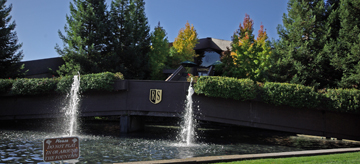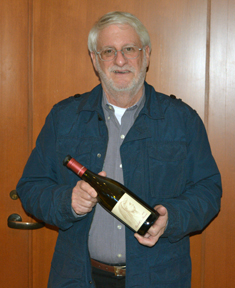WineNotes: Grape Variety: Pinot Noir

Pinot Noir during veraison
Some might consider Pinot Noir wines to be synonymous with Oregon. After all, the renowned Willamette Valley wine region is producing many wines with Pinot Noir grapes. The Pinot Noir grape is a red, vitis vinifera grape that thrives in cooler climates such as Oregon offers. In French the words Pinot Noir refers to pine and black.

Early spring with Pinot Noir
Pinot Noir is considered an international grape. In addition to Oregon, Pinot Noir can be found in many of the world’s wine regions. Those that we visited include California, Canada, France (Burgundy and Champagne), Italy, Spain and New Zealand.
The grapes are finicky due to the thin skin and tight clusters. Grapes are susceptible to powdery mildew and a myriad of other conditions. According to André Tchelistcheff, a renowned winemaker, “God made Cabernet Sauvignon whereas the devil made Pinot Noir.” (from “The Luxury of Pinot Noir: A Deal with the Devil” by John Sears in St. Louis Magazine.
Pinot Noir can be found in red, white, rosé and sparkling wines. The aroma and taste notes can include red berries, earthiness and mushroom characteristics. Terry’s absolute favorite Pinot Noir is from Archery Summit where the Pinot Noir wines can offer intense tannins. My favorite Pinot Noirs are from The Eyrie Vineyards where the wines are aged in old oak barrels with the result of softer tannins.
When pairing Pinot Noir wines with food, consider meats such as pork, beef, veal, lamb and sausage. Salmon also pairs well with Pinot Noir. When planning a meal with chicken or duck, enjoy the meal with a Pinot Noir. End a meal with creme brûlée and a glass of Pinot Noir.
Try this recipe from Seresin Estate, a New Zealand Winery.
Marcia’s Coq Au Vin – via Seresin Estate
Ingredients
1 bottle Pinot Noir
1 carrot, roughly chopped
1 celery stalk, roughly chopped
1 small onion, quartered
4 cloves garlic, peeled and lightly crushed with a knife
1 clove garlic, peeled and finely sliced
1 bay leaf
1 small bunch of thyme
1 T butter
150g (5 oz) streaky bacon, cut into thick chunks
2 T plain flour
4 chicken thighs
2 chicken legs
20 baby onions or 10 shallots, peeled but left whole
20 button mushrooms or 10 white mushrooms, quartered
4 T cognac
Directions
1. Pour the wine into a saucepan and add the carrot, celery, onion, crushed garlic, bay leaf and 4 sprigs thyme. Bring to the boil and reduce by half, then strain and discard the flavourings.
2. Heat the butter over a medium-high flame in a large, heavy-based pan with a lid and then add the bacon. Cook until golden, then lift out with a slotted spoon and put aside. Meanwhile, tip the flour onto a plate and season well. Roll the chicken pieces in it to coat them.
3. Put the chicken in the pan (in batches if necessary) and brown well on all sides, then lift out and set with the bacon. (Your bacon should have given off enough fat for there still to be enough in the pan for the next stage, but if not, add another tablespoon of butter or a glug of oil.)
4. Turn the heat down to medium-low and add the onions or shallots. Cook for about 10 minutes, turning occasionally, until they are beginning to caramelise. Add the mushrooms and sliced garlic and cook for a further 4 minutes, then lift out of the pan and set aside (but not with the meat).
5. Turn up the heat, pour a little of the reduced wine into the pan and scrape the bits off the bottom with a wooden spoon. Put the chicken and bacon back into the pan, reserving some of the bacon for a garnish.
6. Pour over the brandy and set it alight. When the flames have gone out, add the rest of the wine and the thyme leaves. Bring to the boil, turn down the heat, cover and simmer gently for an hour.
7. Add the onions, mushrooms and garlic and simmer for another 20 minutes, keeping the lid on for only half this time. Taste for seasoning and serve with the rest of the bacon sprinkled over the top, with some boiled potatoes or rice.
Serves: 4
Recipe provided by Seresin Estate – Chef Marcia Chang-Hong. Seresin Estate is in Marlborough, New Zealand.
Cheers!
Kathy
 Visiting California’s wineries during September can be a delightful experience. With the many wineries located in California from Northern California to Southern California, there are many activities to from which to choose. 2019 is the 15th annual designated Wine Month for California.
Visiting California’s wineries during September can be a delightful experience. With the many wineries located in California from Northern California to Southern California, there are many activities to from which to choose. 2019 is the 15th annual designated Wine Month for California.-1.5in.jpg)













Maryland Wine Festival 2019 this Weekend!
One of Maryland’s best known annual wine festivals, The Maryland Wine Festival, takes place this weekend, September 21 and September 22019.This festival is intended for the whole family. A varsity of tickets and prices are available; those under under 13 are admitted free with a paying adult. Designated driver tickets are also available. Ticket details are available online.
One of Maryland’s best known annual wine festivals, The Maryland Wine Festival, takes place this weekend, September 21 and September 22, 2019.
This popular wine and food festival includes Maryland wines, food, music, arts and crafts. In addition the festival includes a Local Cheese Pavilion. The event is held at Carroll County Farm Museum in Westminster, Maryland.
Many Maryland wines will be available for tasting; more than 20 wineries will attend. Additional wines will be offered for those with Explorer Pass tickets. The Explorer Pass tickets include a commemorative 16 oz. tasting glass and wines available will also include a sampling of exclusive wines, shaded seating and bottled water. Those with the Explorer Pass can also participate in the 7th Annual Maryland Throwdown – a blind tasting competition. Details for tickets/passes are available online.
Wineries Expected at the Maryland Wine Festival 2019
Wine Trail Traveler has visited many Maryland wineries. Articles and photos are available on the Wine Trail Traveler website.
If you enjoy cheese, be sure to stop at the Local Cheese Pavilion and taste cheeses from: Firefly Farms, Capricorn Farms, Shepherd’s Manor Creamery and Whispering Breeze Farm.
Interested in crafts and artwork? Check out the numerous creative juried artisans.
On Saturday, music will be provided by Foreplay and Half Serious. Sunday will feature Park Avenue and Reagan Years.
About Carroll County Farm Museum
The Carroll County Farm Museum is a highlight of visiting Maryland. According to the museum’s website, “The Carroll County Farm Museum is home to one of the largest collections of historic farm artifacts and machinery in the Mid-Atlantic region.”
Cheers!
Kathy